Cast Iron Gate Valves: Durable Plant Flow Management
Good to know: Over 60% of public distribution networks continue to use conventional isolation gear for secure isolation in emergencies.
Explore our industrial-grade line of Cast Iron Gate Valve Manufacturer designed for extended service life in plant, building, and municipal use across the United States. Every valve combines a robust body-and-bonnet assembly with a time-tested gate design to resist wear and limit corrosion under changing pressure/temperature cycles.
The full-bore gate minimizes flow restriction in the open position, supporting transfer of water and suitable media with less pressure loss. Designers and maintenance teams prefer the straightforward serviceability, common connection options, and easy-to-source parts that simplify selection and repairs.
This range covers several series and class ratings to match typical duty ranges, end connections, and operator preferences. Expect repeatable sealing, steady operating torque, and cost-effective ownership centered on uptime and low life-cycle cost.
Why It Matters
- Designed for rugged shutoff and reliable flow control in diverse environments.
- Rugged construction stands up to wear, corrosion, and mechanical stress.
- Straight-through design delivers minimal resistance and less pressure loss.
- Provided in several series and class ratings to meet typical requirements.
- Service-friendly design, common parts, and consistent sealing improve uptime.
Reliable, Precise Flow Control with Cast Iron Gate Valves
Precision shutoff valves with accurate wedges and precision seats offer consistent performance across startup, steady-state, and shutdown cycles. Solid iron bodies and tight seating produce repeatable sealing. That robustness helps ensure safe isolation and reduces unplanned downtime.
Smooth operating characteristics lower handwheel effort and let technicians position the wedge with confidence. Simple stems and standard accessories allow easy adaptation to manual or automated controls. Less effort speeds routine checks and repairs.

Stem Options and Performance
| Feature | Rising-Stem | Non-Rising Stem |
|---|---|---|
| Open/close visibility | High — easy visual readout | Low — minimal external cue |
| Clearance needs | Requires vertical space | Better for tight or buried service |
| Service | Straightforward inspection | Lower profile, same service life |
Fully open, the straight-through, full-port passage yields low pressure loss and high efficiency flow. Leak-tight closure cuts leakage risk and helps keep target pressure for downstream equipment. As a set, these features trim ownership cost and enhance system uptime across common commercial and light industrial applications.
Design Choices and Options: Cast Iron Gate Valves
Specific design decisions—body alloy, stem style, and flange pattern—determine fit, function, and maintainability.
Body and Bonnet Build
The body and bonnet use cast iron for strength and vibration dampening. Precision-machined guides hold the gate true for consistent sealing.
Rising stem vs non-rising stem
A rising stem provides a visible position reference and is easy to inspect but needs extra headroom. A non-rising stem minimizes vertical space and keeps threads protected inside the bonnet.
Both stem designs are compatible with common handwheels and can be configured for actuators or external indicator posts when automation is required.
Understanding Class 125 Performance
ASME Class 125 is widely used for water and general service within moderate temps. Refer to published pressure-temperature limits to confirm suitability for the intended operating envelope.
Flange connections and dimensions
| Item | Guideline | Notes |
|---|---|---|
| Flange drilling | ASME bolt pattern | Compatible with typical piping |
| End-to-end | Industry series lengths | Check spec sheet for exact dimension |
| Bolting | Grade and torque per spec | Gasket selection affects sealing |
- Sizes and series: available from small line sizes to larger mains with varied series and trim choices for wear resistance and ease of service.
- Trim & packing: seat/wedge materials balance tight shutoff and longevity; upgraded packing and bonnet gasketing improve stem sealing.
- Integration tips: confirm end-to-end dimensions, flange bolt patterns, and torque requirements before installation.
Use Cases, Compliance, and Integration
Applications for these Resilient Seated Gate Valve span municipal mains, building risers, and pump-room isolation points where dependable shutoff is critical.
Water distribution and fire systems commonly apply these as sectional/control points. They offer visible status and reliable shutoff for life safety and utility networks.
Flow & Shutoff in Bi-Directional Service
The gate design allows shutoff in both flow directions when installed as specified. This adaptability simplifies piping layouts and supports redundant piping arrangements.
Maintenance, stem sealing, and bonnet integrity
Accessible bonnet fasteners, guided wedges, and serviceable packing speed inspections and repacking. Proper packing adjustment keeps stem sealing during frequent operating cycles.
Indicators, OS&Y, and Orientation
External indicators and OS&Y styles offer clear open/closed indication for inspections. Even with two-way capability, adhere to the recommended orientation and clearance guidance to ensure safe operation.
| Use Case | Primary Benefit | Spec Check |
|---|---|---|
| Municipal mains | Reliable isolation | Check Class 125 envelope |
| Fire protection | Inspector-friendly indication | Select indicator or OS&Y |
| Building pump rooms | Ease of maintenance | Verify flange and F2F |
Wrap-Up
Invest in proven shutoff equipment that pairs sturdy construction with predictable flow control.
These gate valve solutions provide durable isolation and dependable control for water and utility service. Count on straightforward installation and easy maintenance for lasting reliability.
Key specs include Class 125 rating, a strong body/bonnet set, and engineered stem sealing to keep performance steady across building and plant environments.
Multiple series and common sizes, plus handwheel or actuator-ready configurations, make system matching simple. Clear position indication and low-friction stem travel enhance daily operation and response under variable conditions.
The gate wedge and seat supports leak-tight closure and low pressure loss. Double-check sizes, end connections, and accessories at specification time to speed procurement and commissioning.
Choose valves manufactured to stringent standards. We can review class, sizes, and series to align selections with your operating and maintenance goals.


